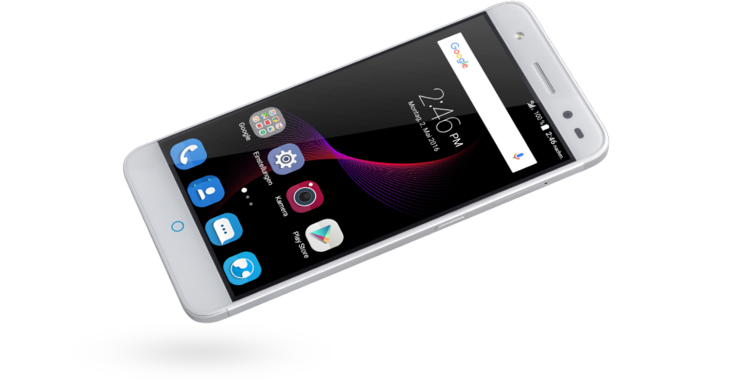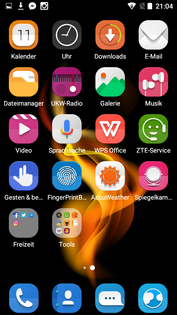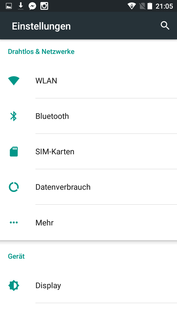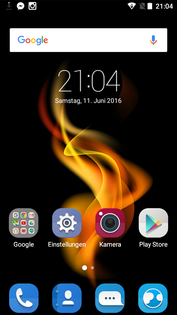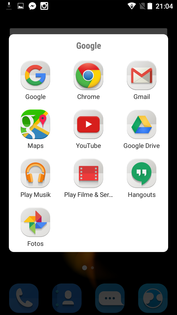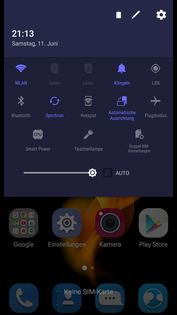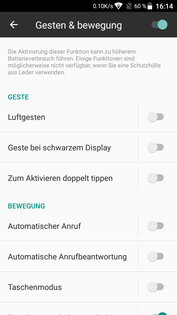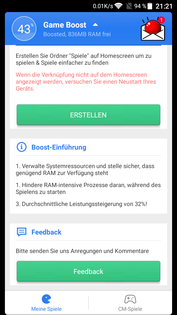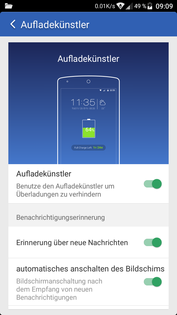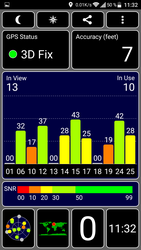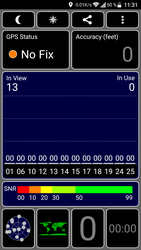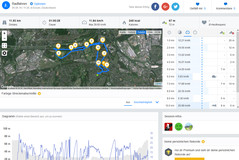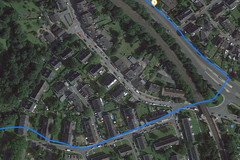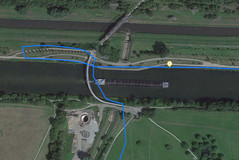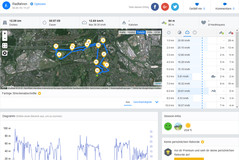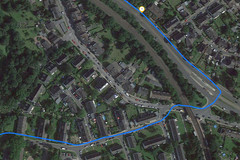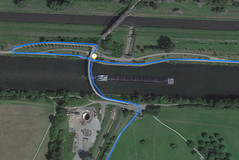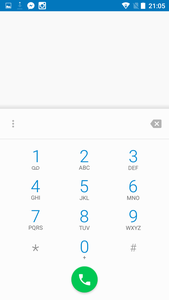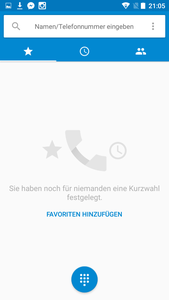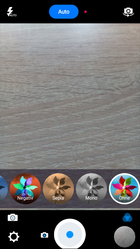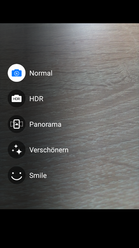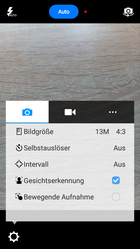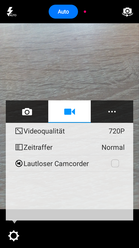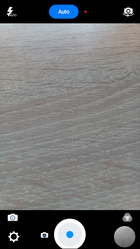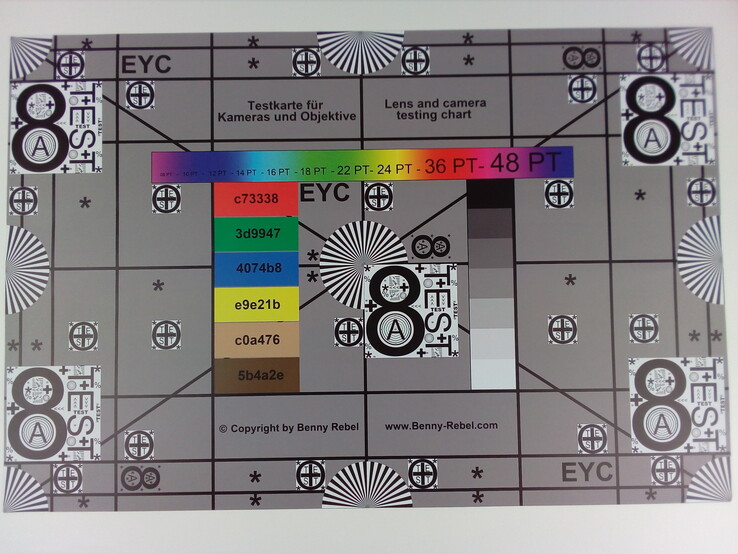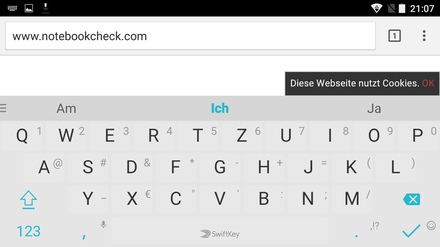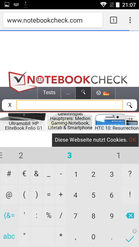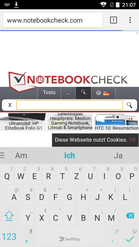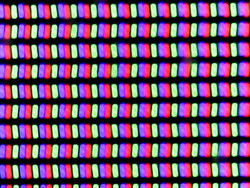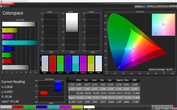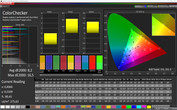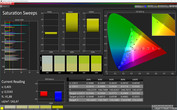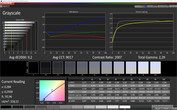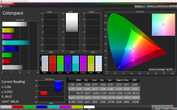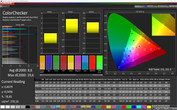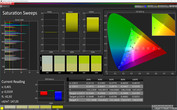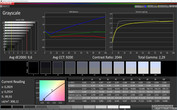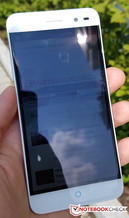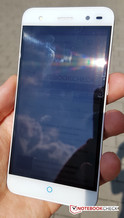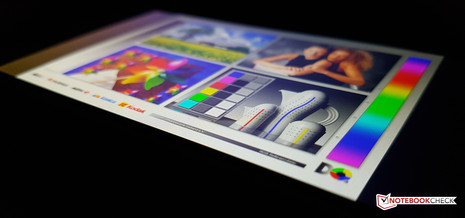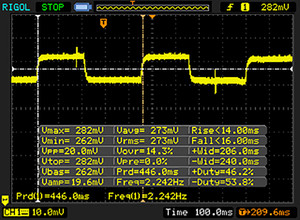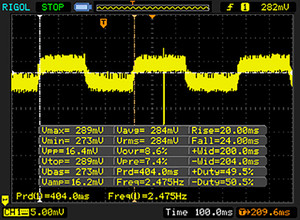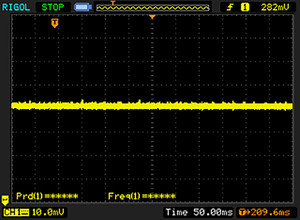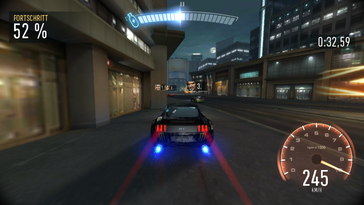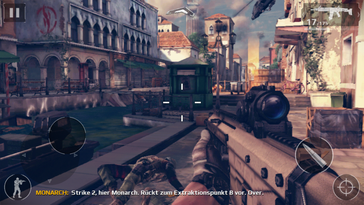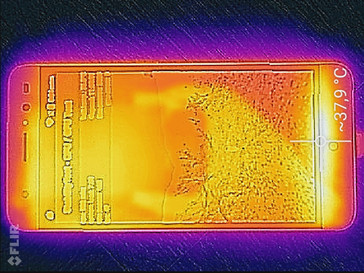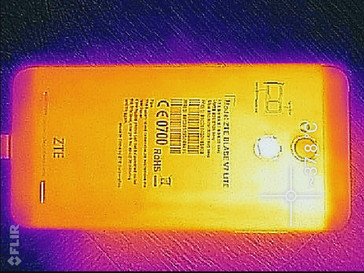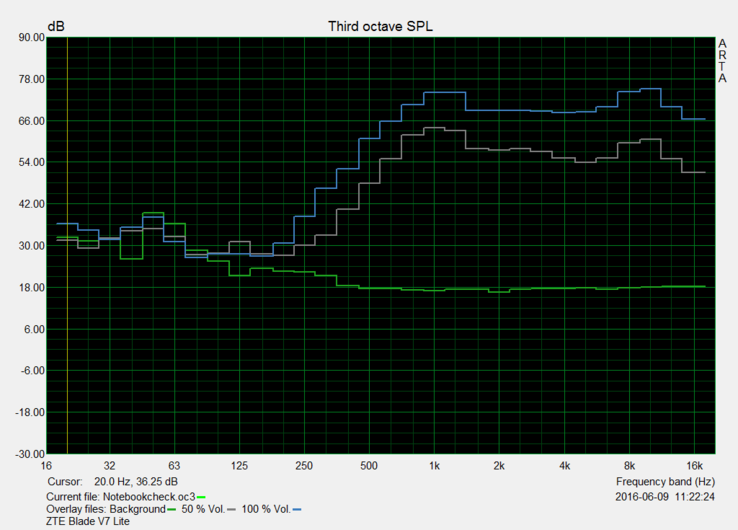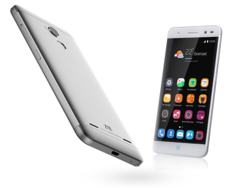ZTE Blade V7 Lite Smartphone Review
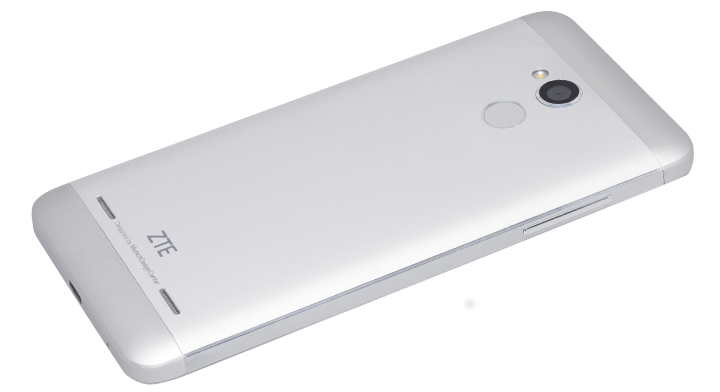
For the original German review, see here.
Following the recently tested Blade V7, we now have another handset by the Chinese telecommunication and network supplier ZTE in our test lab - the ZTE Blade V7 Lite. Both mid-range smartphones, designed and developed in Germany, were introduced at this year's Mobile World Congress in Barcelona. As the suffix in the name suggests, the Blade V7 Lite is a reduced in configuration and performance sister model of the Blade V7.
Besides the smaller 5-inch LCD IPS panel with a high-definition resolution (1280x720 px), the Blade V7 is equipped with only a MediaTek SoC with four cores and a 13 MP primary camera without phase detection autofocus. However, the Lite version presents improvements in some aspects compared with its Blade V7 sister model. It features an 8 MP front camera with an LED flash and an integrated fingerprint scanner on the back.
In Germany ZTE's smartphone comes in light silver and dark gray colors with an RRP of 169 Euros (~$188). Its rivals in this price range and listed as comparison devices in this test are the Coolpad Torino S, the LG K10 and the UMi Touch. However, the Blade V7 sister model is also a possible alternative since the price difference of 80 Euros (~$89) between the "normal" and the Lite models is relatively low.
Case
The metal casing of the Blade V7 Lite is well-built, but it is not made in a unibody design as the manufacturer advertises. As with the Blade V7 sister model, ZTE has installed large plastic parts in the casing's upper and lower edge for the antenna technology in the affordable Lite version. The material transitions are very noticeable, but the gaps are even. Pressure on the handset's plastic edges is enough to provoke a creaking noise.
The 2.5D protective glass on the handset's front is installed in the casing with a light curve. The ratio of glass front and screen is approximately 68.3% in the Blade V7 Lite. The volume and power buttons of our review sample are not very impressive. Both wobble and clatter when used. On the other hand, their pressure points are well-defined.
Overall, the slightly angular design and somewhat higher casing depth of the Blade V7 Lite lead to a poorer feel and handling compared with the Blade V7 sister model. The metal back also feels thinner than and not as high-quality as the material used in the larger sibling.
Connectivity
The internal storage has a capacity of 16 GB. Only about 10.47 GB is left after initial use. When the dual-SIM function of the mid-range smartphone is not used, a micro-SD card (max. 32 GB) can be inserted in the hybrid slot. The manufacturer supports moving applications to the external storage (A2SD functionality). Although ZTE specifies a maximum micro-SD card size of 32 GB for the Blade V7 Lite, the review sample identified our 64 GB Toshiba Exceria Pro M401 reference card.
In addition to a passive fingerprint scanner, an FM radio and status LED are included in the configuration. The micro-USB 2.0 port on the lower edge of the handset supports OTG (on the go). Peripherals can connect to the smartphone via an OTG adapter.
Software
ZTE's smartphone is shippedcomes with Android 6.0 Marshmallow that had has the security patch level from February 2016. The MiFavor user interface is only marginally different from that of the Blade V7 sister model.
Compared with Vanilla Android, the manufacturer's user interface shows visual modifications on the home screen and in the notification list. An app drawer is not implemented in the MiFavor UI, either. All apps are distributed over the home screen after installing them. In returnOn the other hand, the settings menu and folder design resemble Google's stock standard Android.
Applications can be launched via the Smart Sense feature when the screen is disabled. For example, the user can draw an "O" on the disabled screen for directly opening the Internet browser. The fingerprint scanner can also be used as an additional control by mapping it with shortcuts - for example, as camera release.
Communication & GPS
The Wi-Fi module integrated in the Blade V7 Lite supports only the IEEE 802.11 b/g/n standard. The reception performance is decent in routine use, but the Wi-Fi signal is unstable - as with the Blade V7 sister model, the connection was repeatedly disrupted during the test. The attenuation of -40 dBm is relatively low near the router (Telekom Speedport, W921V). The signal strength dropped only marginally on a patio about 4 meters away (~13 ft;-56 dBm). Bluetooth 4.0 is present for near-field communication.
The dual-SIM smartphone accesses mobile Internet with up to two nano-SIM cards. Both slots support quad-band GSM, dual-band UMTS and LTE in the frequency bands 1, 3, 7, 8 and 20. The reception performance was satisfactory.
Localization can be performed via A-GPS with ZTE's Blade V7 Lite. Finding satellites outdoors was fast with an accuracy of 8 feet, approximately 2.5 meters. Connecting to satellites was not possible indoors. The GPS module in the mid-range smartphone tracked the position quite accurately, and showed only minor inaccuracies in the route compared with Garmin's Edge 500 professional navigation system. A difference of almost 160 meters (~175 yd) separates the Blade V7 Lite from Garmin's Edge 500 at the end of the 12.1 kilometer (~7.5 mi) test route.
Telephone & Call Quality
Video calls using the incorporated front camera via Skype and test calls in the German E network functioned without any problems. The call quality using the earpiece and the installed microphone is good. The phone app in the Blade V7 Lite corresponds to Google's application in Android Marshmallow design. The application is clearly arranged and functional.
Cameras
TThe handset's primary camera has a resolution of 13 megapixels in a 4:3 format. Unlike the Blade V7 sister model, the Lite version does not have a phase detection autofocus. The quality of the rear-facing camera module is at most satisfactory. The photos display fewer details and clear blurriness toward the edges (scenes 1 & 2: Bridge and woods). Furthermore, image noise characterizes low-light photos, and they are barely sharp (scene 3: Street). Overall, the photos taken by the Blade V7 Lite's camera module are too dark.
The 8 MP front-facing camera in the handset produces useful results for selfies. As with the rear, an LED flash is installed for low-light photos. ZTE's Blade V7 Lite records videos in HD (1280x720 px) at 30 FPS. The recording quality of 720 p at 30 FPS is the same when using the front camera.
Accessories & Warranty
The accessories include a modular power supply with a nominal output of 5 watts (1 ampere, 5 volts), a USB cable and an in-ear headset.
The warranty period is 24 months.
Input Devices & Handling
The Blade V7 Lite is controlled via three blue backlit, capacitive buttons below the screen. With the exception of the home button, they can be freely mapped with Android-typical commands (back, multitasking). The capacitive multi-touchscreen responds accurately and without delay to inputs. The onscreen keyboard by SwiftKey is preloaded as an input option.
The fingerprint scanner left us with mixed feelings in the test. The recognition rate of biometric identification via fingerprint is on a good level, but sometimes the finger has to be placed on the scanner several times before it is identified. Beyond that, a passive sensor on the handset's back does not offer the desired comfort since the handset has to be awakened from standby before placing the finger on the scanner. The competition (Coolpad Torino S) is faster and more user friendly here.
Display
ZTE relies on a liquid crystal display with a screen diagonal of 12.7 centimeters (5 inches) for its mid-range smartphone. The IPS LCD with a high definition resolution (1280x720 pixels) achieves a pixel density of 294 PPI. Displayed texts as well as very small letters are thus sufficiently sharp.
The LED backlight in the Blade V7 Lite provides an average screen brightness of 302 cd/m² (max. 349 cd/m²). A comparatively poor rate that some rivals clearly outbid. Furthermore, the maximum brightness is dimmed in everyday situations since the realistic APL50 test (average picture level) where bright and dark areas are distributed evenly results in a maximum brightness of just 291 cd/m² in the screen's center. The illumination of 79% is also quite heterogeneous. The comparison models present a more homogeneous brightness distribution here.
| |||||||||||||||||||||||||
Brightness Distribution: 79 %
Center on Battery: 312 cd/m²
Contrast: 2080:1 (Black: 0.15 cd/m²)
ΔE ColorChecker Calman: 8.2 | ∀{0.5-29.43 Ø4.77}
ΔE Greyscale Calman: 9.2 | ∀{0.09-98 Ø5}
Gamma: 2.29
CCT: 9017 K
| ZTE Blade V7 Lite IPS, 1280x720, 5" | ZTE Blade V7 IPS, 1920x1080, 5.2" | Coolpad Torino S IPS, 1280x720, 4.7" | UMI Touch IPS, 1920x1080, 5.5" | LG K10 IPS, 1280x720, 5.3" | LG G5 IPS Quantum, 2560x1440, 5.3" | |
|---|---|---|---|---|---|---|
| Screen | -20% | -17% | -20% | -6% | 23% | |
| Brightness middle (cd/m²) | 312 | 409 31% | 360 15% | 424 36% | 370 19% | 784 151% |
| Brightness (cd/m²) | 302 | 411 36% | 358 19% | 415 37% | 355 18% | 774 156% |
| Brightness Distribution (%) | 79 | 96 22% | 87 10% | 91 15% | 92 16% | 91 15% |
| Black Level * (cd/m²) | 0.15 | 0.38 -153% | 0.45 -200% | 0.54 -260% | 0.28 -87% | 0.43 -187% |
| Contrast (:1) | 2080 | 1076 -48% | 800 -62% | 785 -62% | 1321 -36% | 1823 -12% |
| Colorchecker dE 2000 * | 8.2 | 9.4 -15% | 6.8 17% | 6.9 16% | 6.7 18% | 6.5 21% |
| Colorchecker dE 2000 max. * | 16.5 | 17.6 -7% | 11.3 32% | 10.9 34% | 17.8 -8% | 11.7 29% |
| Greyscale dE 2000 * | 9.2 | 11.6 -26% | 6.2 33% | 6.8 26% | 7.9 14% | 8 13% |
| Gamma | 2.29 96% | 2.25 98% | 2.14 103% | 1.99 111% | 2.21 100% | 2.22 99% |
| CCT | 9017 72% | 9597 68% | 7975 82% | 8131 80% | 9072 72% | 8699 75% |
| Color Space (Percent of AdobeRGB 1998) (%) | 68.08 | |||||
| Color Space (Percent of sRGB) (%) | 97.46 |
* ... smaller is better
Both the black level of 0.15 cd/m² (APL50 test: 0.22 cd/m²) and contrast ratio of 2080:1 are on a very good level - however, the good rates are also due to the screen's low brightness. The LCD panel shows weaknesses in color reproduction. The analysis using a photospectrometer and CalMAN software shows a relatively large shift in color (8.2) and grayscale (9.2) reproduction at a target rate of <3. The measured color temperature of 9017 Kelvin is clearly too cool. This leads to a light yet visible bluish tint in routine use.
The drawbacks of the dark, low-brightness IPS panel become obvious in the outdoors. The mid-range smartphone cannot compensate for reflections and direct sunlight even in the maximum brightness level. As typical for IPS, the viewing angles are on a high level. Content barely dims even from very flat viewing angles.
Display Response Times
| ↔ Response Time Black to White | ||
|---|---|---|
| 30 ms ... rise ↗ and fall ↘ combined | ↗ 14 ms rise | |
| ↘ 16 ms fall | ||
| The screen shows slow response rates in our tests and will be unsatisfactory for gamers. In comparison, all tested devices range from 0.1 (minimum) to 240 (maximum) ms. » 79 % of all devices are better. This means that the measured response time is worse than the average of all tested devices (20.2 ms). | ||
| ↔ Response Time 50% Grey to 80% Grey | ||
| 44 ms ... rise ↗ and fall ↘ combined | ↗ 20 ms rise | |
| ↘ 24 ms fall | ||
| The screen shows slow response rates in our tests and will be unsatisfactory for gamers. In comparison, all tested devices range from 0.165 (minimum) to 636 (maximum) ms. » 73 % of all devices are better. This means that the measured response time is worse than the average of all tested devices (31.6 ms). | ||
Screen Flickering / PWM (Pulse-Width Modulation)
| Screen flickering / PWM not detected | |||
In comparison: 53 % of all tested devices do not use PWM to dim the display. If PWM was detected, an average of 8084 (minimum: 5 - maximum: 343500) Hz was measured. | |||
Performance
The Blade V7 Lite is powered by an ARM SoC (system on a chip) from 2015. It is an upper mid-range model by MediaTek. The MT6735 is built in 28 nanometers and has four CPU cores based on the 64-bit capable Cortex A53 architecture.
The performance impressed us to some degree only in routine use. Stutters and lags, as well as delays when opening apps were observed during multitasking load. Furthermore, our review sample sometimes did not respond to inputs, and the handset had to be rebooted. Browsing via the preloaded Chrome browser often needed longer loading times before websites were set up. The benchmark scores display similar results. Coolpad's Porto S, for example, proves that better performance is possible with MediaTek's SoC.
The PCMark benchmark could not be launched properly after installing it on our review sample. Downloading additional application files resulted in system crashes (several times).
The internal storage offers good access rates on a similar level as the Blade V7 sister model. However, the integrated micro-SD card reader is not the fastest. We tested its speed with our Toshiba Exceria Pro M401 reference memory card (max. read: 95 MB/s, write: 80 MB/s. The slot's performance of 22.77 MB/s (read) and 12.64 MB/s (write) is below average.
| AndroBench 3-5 | |
| Sequential Write 256KB SDCard (sort by value) | |
| ZTE Blade V7 Lite | |
| ZTE Blade V7 | |
| Coolpad Torino S | |
| UMI Touch | |
| LG K10 | |
| LG G5 | |
| Sequential Read 256KB SDCard (sort by value) | |
| ZTE Blade V7 Lite | |
| ZTE Blade V7 | |
| Coolpad Torino S | |
| UMI Touch | |
| LG K10 | |
| LG G5 | |
| Random Write 4KB (sort by value) | |
| ZTE Blade V7 Lite | |
| ZTE Blade V7 | |
| Coolpad Torino S | |
| UMI Touch | |
| LG K10 | |
| LG G5 | |
| Random Read 4KB (sort by value) | |
| ZTE Blade V7 Lite | |
| ZTE Blade V7 | |
| Coolpad Torino S | |
| UMI Touch | |
| LG K10 | |
| LG G5 | |
| Sequential Write 256KB (sort by value) | |
| ZTE Blade V7 Lite | |
| ZTE Blade V7 | |
| Coolpad Torino S | |
| UMI Touch | |
| LG K10 | |
| LG G5 | |
| Sequential Read 256KB (sort by value) | |
| ZTE Blade V7 Lite | |
| ZTE Blade V7 | |
| Coolpad Torino S | |
| UMI Touch | |
| LG K10 | |
| LG G5 | |
| AnTuTu v6 - Total Score (sort by value) | |
| ZTE Blade V7 Lite | |
| ZTE Blade V7 | |
| Coolpad Torino S | |
| UMI Touch | |
| LG K10 | |
| LG G5 | |
| Geekbench 3 | |
| 64 Bit Single-Core Score (sort by value) | |
| ZTE Blade V7 Lite | |
| ZTE Blade V7 | |
| Coolpad Torino S | |
| UMI Touch | |
| LG K10 | |
| LG G5 | |
| 64 Bit Multi-Core Score (sort by value) | |
| ZTE Blade V7 Lite | |
| ZTE Blade V7 | |
| Coolpad Torino S | |
| UMI Touch | |
| LG K10 | |
| LG G5 | |
| GFXBench (DX / GLBenchmark) 2.7 | |
| T-Rex Onscreen (sort by value) | |
| ZTE Blade V7 Lite | |
| ZTE Blade V7 | |
| Coolpad Torino S | |
| UMI Touch | |
| LG K10 | |
| LG G5 | |
| 1920x1080 T-Rex Offscreen (sort by value) | |
| ZTE Blade V7 Lite | |
| ZTE Blade V7 | |
| Coolpad Torino S | |
| UMI Touch | |
| LG K10 | |
| LG G5 | |
| GFXBench 3.0 | |
| on screen Manhattan Onscreen OGL (sort by value) | |
| ZTE Blade V7 Lite | |
| ZTE Blade V7 | |
| Coolpad Torino S | |
| UMI Touch | |
| LG K10 | |
| LG G5 | |
| 1920x1080 1080p Manhattan Offscreen (sort by value) | |
| ZTE Blade V7 Lite | |
| ZTE Blade V7 | |
| Coolpad Torino S | |
| UMI Touch | |
| LG K10 | |
| LG G5 | |
| GFXBench 3.1 | |
| on screen Manhattan ES 3.1 Onscreen (sort by value) | |
| ZTE Blade V7 Lite | |
| ZTE Blade V7 | |
| UMI Touch | |
| LG K10 | |
| LG G5 | |
| 1920x1080 Manhattan ES 3.1 Offscreen (sort by value) | |
| ZTE Blade V7 Lite | |
| ZTE Blade V7 | |
| UMI Touch | |
| LG K10 | |
| LG G5 | |
| Octane V2 - Total Score (sort by value) | |
| ZTE Blade V7 Lite | |
| ZTE Blade V7 | |
| Coolpad Torino S | |
| UMI Touch | |
| LG K10 | |
| LG G5 | |
| Mozilla Kraken 1.1 - Total (sort by value) | |
| ZTE Blade V7 Lite | |
| ZTE Blade V7 | |
| Coolpad Torino S | |
| UMI Touch | |
| LG K10 | |
| LG G5 | |
| JetStream 1.1 - Total Score (sort by value) | |
| ZTE Blade V7 Lite | |
| ZTE Blade V7 | |
| Coolpad Torino S | |
| UMI Touch | |
| LG K10 | |
| LG G5 | |
* ... smaller is better
Games
The ARM Mali-T720 (MP1) responsible for video output was only enough for a conditionally smooth performance with up-to-date games, such as "Need for Speed No Limits" and "Modern Combat 5". Stutters and prolonged loading times during gameplay were often noticed. Similar behavior could be observed in the test of the Blade V7 sister model that is equipped with much stronger hardware.
Emissions
Temperature
The temperature development of the mid-range smartphone is barely noticeable in routine use. The temperatures remain pleasant, even in load conditions. The Blade V7 Lite heats up to a maximum of 38.5 °C (~101 °F) when the system is loaded heavily (CPU and GPU) via the Stability Test app for at least one hour - a good rate.
(+) The maximum temperature on the upper side is 38.5 °C / 101 F, compared to the average of 35.2 °C / 95 F, ranging from 21.9 to 247 °C for the class Smartphone.
(+) The bottom heats up to a maximum of 36 °C / 97 F, compared to the average of 34 °C / 93 F
(±) In idle usage, the average temperature for the upper side is 32.5 °C / 91 F, compared to the device average of 32.9 °C / 91 F.
Speaker
The rear-sided speaker's maximum volume is sufficient for everyday use, but it is comparatively quiet at 82.6 dB(A). The playback quality is mostly satisfactory. However, the sound gets tinny when the volume is increased. The Pink Noise diagram illustrates that medium and high frequencies of 1 to 10 kHz are quite linear. As typical for smartphones, the sound impression almost completely lacks basses.
Energy Management
Power Consumption
The Blade V7 Lite cannot be criticized in terms of power consumption. The energy requirement is very low, particularly in load conditions.
| Off / Standby | |
| Idle | |
| Load |
|
Key:
min: | |
| ZTE Blade V7 Lite 2500 mAh | ZTE Blade V7 2540 mAh | Coolpad Torino S 1800 mAh | UMI Touch 4000 mAh | LG K10 2300 mAh | LG G5 2800 mAh | |
|---|---|---|---|---|---|---|
| Power Consumption | -15% | -27% | -44% | -62% | ||
| Idle Minimum * (Watt) | 0.63 | 0.73 -16% | 0.68 -8% | 0.89 -41% | 0.55 13% | |
| Idle Average * (Watt) | 1.37 | 0.92 33% | 2.2 -61% | 2 -46% | 1.37 -0% | |
| Idle Maximum * (Watt) | 1.71 | 0.93 46% | 2.26 -32% | 2.1 -23% | 2.25 -32% | |
| Load Average * (Watt) | 2.82 | 4.47 -59% | 3.47 -23% | 3.87 -37% | 6.24 -121% | |
| Load Maximum * (Watt) | 3.36 | 5.96 -77% | 3.71 -10% | 5.79 -72% | 9.12 -171% |
* ... smaller is better
Battery Runtime
In the test, the Blade V7 Lite presents good runtimes in everyday conditions (screen brightness: 150 cd/m²; energy-savings profile). With 8 hours and 37 minutes in the Wi-Fi test, ZTE's handset is on par with its rivals. However, the 2500 mAh battery only achieves similarly good runtimes as the Blade V7 with higher performance specifications and a larger, higher resolution screen.
Recharging takes about 2.5 hours despite the proprietary quick charge function.
| ZTE Blade V7 Lite 2500 mAh | ZTE Blade V7 2540 mAh | Coolpad Torino S 1800 mAh | UMI Touch 4000 mAh | LG K10 2300 mAh | LG G5 2800 mAh | |
|---|---|---|---|---|---|---|
| Battery runtime | ||||||
| WiFi v1.3 (h) | 8.6 | 8.7 1% | 6.6 -23% | 9.2 7% | 7.6 -12% | 6.5 -24% |
Pros
Cons
Verdict
In our tests, the Blade V7 Lite presented itself as a good mid-range handset from the lower price range in a quality metal casing and with a decent battery life. However, it also exhibited a few shortcomings. The IPS panel is solid and high-contrast, but it has a below average brightness and uneven illumination. The processor and graphics unit performance was not convincing in the test. The fingerprint scanner is fast, but it does not offer the desired comfort due to its passive functionality. The photos of the 13 MP camera module are satisfactory for the price range - nevertheless comparable models (UMi Touch, Coolpad Torino S) present a better photo quality, particularly in terms of dynamic range.
The Blade V7 Lite shows weaknesses in the core aspects of display and performance as well as speaker quality. Although ZTE's smartphone comes in a stylish aluminum casing for this price range, it is doubtful whether that is enough.
If price is not an issue, then purchasing the larger sister model, ZTE Blade V7, is advisable. Despite its higher purchase price, it offers a better price-performance ratio. We also recommend the slightly larger, 5.5-inch UMi Touch if the buyer does not shy away from purchasing via import companies - the "smartphone made in China" costs about 100 Euros (~$111) less and features a similarly good configuration.
ZTE Blade V7 Lite
- 06/21/2016 v5.1 (old)
Marcus Herbrich




